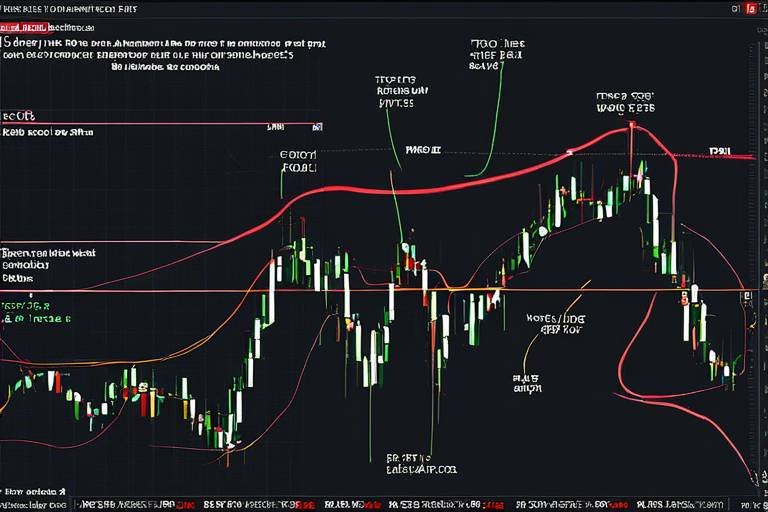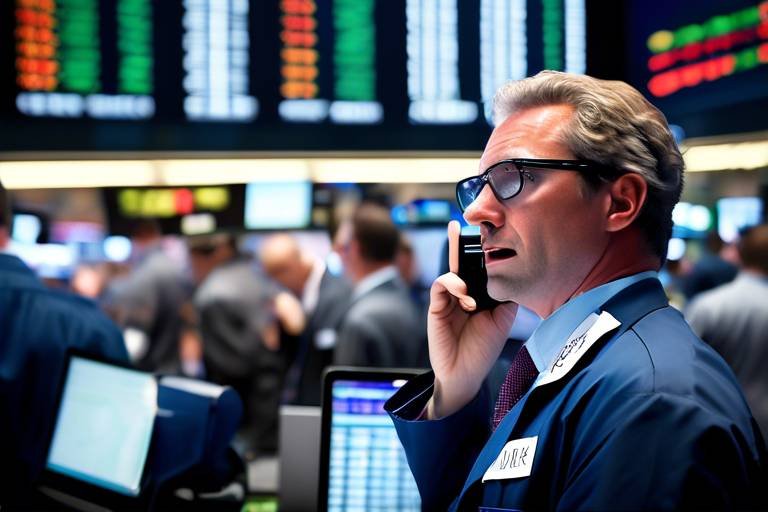Understanding Cryptocurrency Market Capitalization
In the ever-evolving world of digital currencies, understanding the concept of market capitalization is crucial for both seasoned investors and newcomers alike. Market capitalization, often referred to as "market cap," serves as a vital indicator of a cryptocurrency's overall value and market presence. But what exactly does it mean, and why is it so important? In this article, we will delve into the intricacies of market capitalization in the cryptocurrency space, exploring its significance, how it is calculated, and its implications for investors navigating the dynamic crypto landscape.
Market capitalization refers to the total value of a cryptocurrency, calculated by multiplying its current price by the total supply of coins in circulation. This simple formula provides a snapshot of a cryptocurrency’s size and its position within the market. For instance, if a cryptocurrency has a current price of $50 and there are 1 million coins in circulation, its market cap would be $50 million. This figure is not just a number; it is a reflection of the cryptocurrency's market presence and can significantly influence investor decisions.
The calculation of market capitalization is straightforward and can be summarized with the following formula:
Market Capitalization Current Price x Circulating Supply
This formula helps investors assess the relative size of different cryptocurrencies. By comparing market caps, one can gauge which cryptocurrencies are leading the pack and which ones are still emerging. However, it’s essential to remember that a higher market cap does not always equate to a better investment; it merely indicates the size of the cryptocurrency in the market.
Several factors can impact a cryptocurrency's market cap, including:
- Technological advancements: Innovations such as upgrades, forks, or new features can significantly affect a cryptocurrency's market cap by enhancing utility or attracting new investors, thus driving demand and price.
- Market demand: The level of interest from investors and users can cause fluctuations in demand, directly impacting market cap.
- Regulatory news: Changes in regulations can either bolster or hinder cryptocurrency adoption, impacting market sentiment and market cap.
- Macroeconomic trends: Economic factors such as inflation rates, interest rates, and global economic stability can influence investor behavior and market dynamics.
Understanding these influences is crucial for investors navigating the crypto landscape, as they can lead to rapid changes in market capitalization.
Technological developments play a pivotal role in shaping a cryptocurrency's market cap. Innovations such as upgrades, forks, or the introduction of new features can enhance a cryptocurrency's utility. For instance, if a blockchain network introduces a new feature that significantly improves transaction speed or security, it can attract new investors and drive demand, leading to an increase in market cap.
Market sentiment is another critical factor that can lead to rapid fluctuations in market capitalization. The perception of a cryptocurrency, shaped by news, social media, and investor behavior, can cause dramatic price movements. For example, a positive news story about a cryptocurrency can lead to a surge in investor interest, driving up the price and, consequently, the market cap. Conversely, negative sentiment can result in swift declines, highlighting the volatile nature of the crypto market.
While market cap provides a snapshot of a cryptocurrency's size, trading volume indicates the level of activity and liquidity. A high trading volume often suggests strong investor interest and can influence market cap. For instance, a cryptocurrency might have a large market cap, but if its trading volume is low, it could indicate a lack of investor confidence. Conversely, a cryptocurrency with a smaller market cap but high trading volume might be experiencing growing interest and potential for future growth.
Market capitalization can be categorized into three types: large-cap, mid-cap, and small-cap cryptocurrencies. Each category has distinct characteristics and risk profiles, guiding investors in their strategies.
Large-cap cryptocurrencies, often seen as more stable, typically have a market cap exceeding $10 billion. These cryptocurrencies are generally less volatile and are considered safer investments for risk-averse investors. Examples include Bitcoin and Ethereum, which dominate the market with substantial market caps and established user bases.
On the other hand, small-cap cryptocurrencies, with market caps under $1 billion, can offer higher growth potential but come with increased risk and volatility. These cryptocurrencies often attract investors looking for opportunities in emerging projects. However, it’s essential to approach small-cap investments with caution, as they can be more susceptible to market swings.
1. What is the importance of market capitalization in cryptocurrency?
Market capitalization helps investors assess the size and stability of a cryptocurrency, guiding their investment decisions.
2. How can market cap influence investment decisions?
A higher market cap often indicates a more established cryptocurrency, which may be considered a safer investment compared to smaller, less established coins.
3. What should I consider when looking at market cap?
While market cap is important, it’s also essential to consider trading volume, market sentiment, and technological developments when making investment decisions.

What is Market Capitalization?
Market capitalization, often referred to as "market cap," is a fundamental concept in the world of cryptocurrency and finance. It represents the total value of a cryptocurrency, calculated by multiplying its current price by the total supply of coins available in the market. This simple yet powerful formula provides a quick snapshot of a cryptocurrency's size and market presence, helping investors gauge its significance in the broader crypto ecosystem.
To illustrate, imagine you have a cryptocurrency called "CryptoX." If CryptoX is currently priced at $50 and there are 1 million coins in circulation, the market capitalization would be calculated as follows:
| Cryptocurrency | Current Price (USD) | Circulating Supply | Market Capitalization (USD) |
|---|---|---|---|
| CryptoX | $50 | 1,000,000 | $50,000,000 |
With a market cap of $50 million, CryptoX is positioned as a mid-tier player in the cryptocurrency market. This categorization is essential for investors as it allows them to compare different cryptocurrencies on a relative scale. A higher market cap often indicates a more established and stable asset, while lower market caps can suggest higher volatility and risk.
Understanding market capitalization is crucial for making informed investment decisions. It provides insight into the health and potential of a cryptocurrency. For instance, a cryptocurrency with a market cap exceeding $10 billion is generally considered a large-cap asset, often associated with greater stability and lower risk. Conversely, small-cap cryptocurrencies, with market caps under $1 billion, may present exciting opportunities for growth but come with a higher level of risk.
In summary, market capitalization serves as a vital metric for assessing the value and potential of cryptocurrencies. By keeping an eye on market cap, investors can better navigate the complex landscape of digital assets, making strategic decisions that align with their financial goals.

How is Market Capitalization Calculated?
Calculating market capitalization in the cryptocurrency world is as simple as pie, yet it holds immense significance for investors. At its core, market capitalization is determined by a straightforward formula: Market Cap Current Price x Circulating Supply. This means that to find the market cap of any cryptocurrency, you just need to multiply the current price of a single coin by the total number of coins that are currently in circulation.
Let’s break this down a bit further. Imagine you’re eyeing a cryptocurrency that has a current price of $50 and a circulating supply of 1 million coins. By applying our formula, you would calculate:
| Cryptocurrency | Current Price | Circulating Supply | Market Capitalization |
|---|---|---|---|
| ExampleCoin | $50 | 1,000,000 | $50,000,000 |
So, in this case, the market cap of ExampleCoin would be $50 million. This figure gives investors a snapshot of the cryptocurrency's size and its standing in the market. The higher the market cap, the more significant the cryptocurrency is considered to be. It’s like a badge of honor in the crypto world—larger market caps often imply greater stability and less risk.
However, it’s essential to understand that market capitalization is not the only metric to consider. It provides a basic overview, but it doesn’t tell the whole story. For instance, a cryptocurrency with a high market cap can still be subject to volatility, especially if it experiences sudden shifts in market sentiment or regulatory changes. Consequently, investors should also look at other factors such as trading volume, technology, and market sentiment to get a well-rounded view of a cryptocurrency's potential.
In summary, calculating market capitalization is simple, yet it serves as a crucial tool for investors. By understanding the formula and its implications, you can make more informed decisions about your investments. Just remember, while market cap is a vital indicator, it’s just one piece of the puzzle in the ever-evolving landscape of cryptocurrency.
- What does a high market cap indicate? A high market cap generally indicates a more stable and established cryptocurrency, which may be less volatile compared to smaller coins.
- Can market cap change? Yes, market cap can fluctuate based on changes in the coin's price and circulating supply.
- Is market cap the only thing to consider when investing? No, while market cap is important, investors should also consider trading volume, technology, and market sentiment.

Factors Influencing Market Capitalization
When it comes to understanding the cryptocurrency market, it's crucial to recognize that market capitalization does not exist in a vacuum. Several dynamic factors can significantly influence a cryptocurrency's market cap, making it a constantly shifting landscape. For instance, technological advancements play a pivotal role. When a cryptocurrency undergoes a major upgrade or introduces new features, it can enhance its utility and attract a wave of new investors. This, in turn, can drive up demand and, consequently, the price, leading to a higher market cap.
Another key player in this equation is market sentiment. Imagine the crypto market as a bustling marketplace where news and social media buzz can create a whirlwind of activity. Positive news, such as a major partnership or regulatory approval, can spark excitement, causing prices to soar. Conversely, negative sentiment, perhaps stemming from regulatory crackdowns or security breaches, can lead to panic selling. This emotional rollercoaster can lead to rapid fluctuations in market capitalization, making it essential for investors to stay informed and vigilant.
Furthermore, macroeconomic trends also have a hand in shaping market capitalization. Factors like inflation rates, interest rates, and global economic stability can influence investor behavior and market demand. For example, during times of economic uncertainty, investors may flock to cryptocurrencies as a hedge against traditional market volatility, boosting their market cap. In contrast, a stable economic environment might see investors diverting their attention back to traditional assets, leading to potential declines in market cap.
To summarize, the interplay between technological developments, market sentiment, and macroeconomic trends creates a complex web that influences cryptocurrency market capitalization. Understanding these factors is not just beneficial but essential for any investor looking to navigate this exciting yet unpredictable landscape.
- What is market capitalization? Market capitalization is the total value of a cryptocurrency, calculated by multiplying its current price by the total supply of coins.
- How is market capitalization calculated? It is calculated using the formula: Market Cap Current Price × Circulating Supply.
- What factors influence market capitalization? Factors include technological advancements, market sentiment, and macroeconomic trends.
- What are large-cap, mid-cap, and small-cap cryptocurrencies? These terms categorize cryptocurrencies based on their market capitalization, with large-cap being over $10 billion, mid-cap between $1 billion and $10 billion, and small-cap under $1 billion.

Technological Developments
In the fast-paced world of cryptocurrency, play a pivotal role in shaping the market landscape. These innovations can either propel a cryptocurrency to new heights or sink it into obscurity. For instance, when a blockchain undergoes a significant upgrade, it often leads to enhanced functionality and security, which can attract new users and investors. Imagine a smartphone that just got a major software update; suddenly, it runs smoother, has new features, and becomes more appealing to potential buyers. Similarly, cryptocurrencies that embrace technological advancements can see a surge in demand.
One of the most notable examples of this is the introduction of smart contracts on platforms like Ethereum. Smart contracts automate transactions and eliminate the need for intermediaries, making processes faster and more cost-effective. This innovation has not only increased Ethereum's market cap but has also inspired countless projects to build on its platform, creating a thriving ecosystem.
Moreover, forks—where a cryptocurrency splits into two separate coins—can also impact market capitalization. A famous case is the Bitcoin Cash fork from Bitcoin. While this split created a new cryptocurrency, it also sparked debates and divided the community, leading to fluctuations in market sentiment and value. Such events highlight how technological changes can ripple through the market, affecting investor confidence and ultimately, market cap.
Additionally, the emergence of Layer 2 solutions like the Lightning Network for Bitcoin aims to address scalability issues, allowing for faster transactions at lower costs. This kind of technological innovation is crucial for cryptocurrencies to remain competitive and relevant in a rapidly evolving digital landscape. When users experience faster and cheaper transactions, they are more likely to engage with the platform, leading to increased adoption and a higher market cap.
In summary, technological developments are not just enhancements; they are the lifeblood of the cryptocurrency market. As these innovations unfold, they create waves of opportunity and risk. Investors must stay informed and agile, ready to adapt to the shifting tides brought about by these advancements. After all, in the world of crypto, staying ahead of the curve is key to capitalizing on potential growth.
- What is market capitalization in cryptocurrency?
Market capitalization refers to the total value of a cryptocurrency, calculated by multiplying its current price by the total supply of coins. - How does technological development affect cryptocurrency?
Technological advancements can enhance utility, attract investors, and ultimately influence a cryptocurrency's market cap. - What are smart contracts?
Smart contracts are self-executing contracts with the terms of the agreement directly written into code, enabling automated transactions. - What is a cryptocurrency fork?
A cryptocurrency fork occurs when a blockchain splits into two separate chains, often resulting in the creation of a new cryptocurrency.

Market Sentiment
Market sentiment is a crucial element in the cryptocurrency world, acting as the emotional barometer for investors and traders alike. It reflects the general attitude and mood of the market participants towards a particular cryptocurrency or the market as a whole. Think of it as the collective heartbeat of the crypto community; when the pulse is racing, you can expect volatility, and when it slows down, things might get a bit stagnant. But what exactly drives this sentiment?
Several factors can sway market sentiment, including news headlines, social media trends, and broader economic indicators. For instance, a positive announcement from a major company adopting a cryptocurrency can send prices soaring, while negative regulatory news can trigger panic selling. It's like a rollercoaster ride where the highs can be exhilarating, but the lows can be gut-wrenching.
Moreover, sentiment is not just about what is happening in the crypto space; it is also influenced by the global economic landscape. Economic downturns, inflation rates, and even geopolitical tensions can affect how investors perceive the value and future potential of cryptocurrencies. When traditional markets are shaky, many turn to crypto as a hedge, which can lead to a surge in positive sentiment.
To illustrate how sentiment can shift rapidly, consider the following table that outlines different scenarios and their potential impact on market sentiment:
| Scenario | Impact on Market Sentiment |
|---|---|
| Major adoption by a Fortune 500 company | Positive surge, increased buying interest |
| Regulatory crackdowns in key markets | Negative sentiment, potential sell-off |
| Positive technological upgrades or forks | Increased optimism, potential price rise |
| Negative news or hacks | Panic selling, rapid price declines |
Understanding market sentiment is essential for any investor looking to navigate the unpredictable waters of cryptocurrency. It’s not just about numbers; it’s about the stories, fears, and hopes of the people involved. By keeping an ear to the ground and staying updated with news and social media discussions, you can better predict potential market movements. After all, in the world of crypto, sentiment can change as quickly as the price of Bitcoin!
- What is market sentiment? - Market sentiment refers to the overall attitude of investors towards a particular cryptocurrency or the market in general.
- How does market sentiment affect cryptocurrency prices? - Positive sentiment can lead to increased buying activity, driving prices up, while negative sentiment can result in selling pressure and price declines.
- What factors influence market sentiment? - Factors include news events, social media trends, economic indicators, and overall investor behavior.
- Can market sentiment change quickly? - Yes, market sentiment can shift rapidly based on new information or events, leading to significant price volatility.

Market Capitalization vs. Trading Volume
When diving into the world of cryptocurrency, it's essential to understand the difference between market capitalization and trading volume. While both metrics are crucial for evaluating a cryptocurrency's performance, they serve different purposes and can tell investors quite different stories. Think of market cap as a snapshot of a cryptocurrency's overall value at a given moment, while trading volume reveals the level of activity and interest in that cryptocurrency over a specific period.
Market capitalization is calculated by multiplying the current price of a cryptocurrency by its circulating supply. This figure gives investors an idea of the cryptocurrency's size and market presence. For example, if a cryptocurrency has a price of $100 and a circulating supply of 1 million coins, its market cap would be $100 million. This makes it easier to compare the relative size of different cryptocurrencies. However, just because a cryptocurrency has a high market cap doesn't necessarily mean it's a good investment.
On the other hand, trading volume reflects how much of a cryptocurrency has been traded within a certain timeframe, often measured in 24 hours. High trading volume indicates strong investor interest and liquidity, meaning it's easier to buy and sell the asset without causing significant price changes. In contrast, low trading volume can lead to higher price volatility, as even a small number of trades can dramatically affect the price.
To illustrate this further, consider the following table that compares two hypothetical cryptocurrencies:
| Cryptocurrency | Market Cap ($) | 24-Hour Trading Volume ($) |
|---|---|---|
| Crypto A | 1,000,000,000 | 50,000,000 |
| Crypto B | 1,000,000,000 | 5,000,000 |
In this example, both Crypto A and Crypto B have the same market capitalization of $1 billion. However, Crypto A has a significantly higher trading volume compared to Crypto B. This suggests that Crypto A is more actively traded and likely has a more liquid market, making it easier for investors to enter and exit positions without causing drastic price shifts.
Investors should pay attention to both metrics when making decisions. A high market cap combined with low trading volume might indicate that while the cryptocurrency is established, it lacks active interest from investors, potentially leading to stagnation. Conversely, a low market cap with high trading volume could signal a growing interest in a smaller cryptocurrency, but it may also come with higher risks.
In summary, understanding the relationship between market capitalization and trading volume can provide valuable insights into the dynamics of the cryptocurrency market. By analyzing both metrics, investors can make more informed decisions, balancing potential risks and rewards as they navigate this ever-evolving landscape.
- What is the significance of market capitalization in cryptocurrency? Market capitalization helps investors gauge the relative size of a cryptocurrency, which can influence investment decisions.
- How can trading volume impact my investment strategy? High trading volume indicates strong market interest and liquidity, making it easier to buy or sell without affecting the price significantly.
- Can a cryptocurrency have a high market cap and low trading volume? Yes, this can happen, and it may indicate that while the cryptocurrency is established, it lacks active investor interest.

Types of Market Capitalization
When diving into the world of cryptocurrency, it's essential to understand that not all digital currencies are created equal. Market capitalization, or market cap, serves as a crucial metric to categorize cryptocurrencies into different tiers based on their total value. This categorization not only helps investors gauge the size and stability of a cryptocurrency but also aids in formulating investment strategies. The three primary types of market capitalization are large-cap, mid-cap, and small-cap cryptocurrencies. Each of these categories comes with its own unique characteristics, risk profiles, and potential for growth.
Large-cap cryptocurrencies are generally considered the giants of the crypto market. With a market cap exceeding $10 billion, these cryptocurrencies are often viewed as more stable investments. Think of them as the blue-chip stocks of the crypto world. They are typically well-established, have a significant user base, and are less prone to drastic price fluctuations compared to their smaller counterparts. Investors often flock to large-cap cryptocurrencies during times of market uncertainty, as they provide a sense of security due to their established presence and liquidity.
On the flip side, we have small-cap cryptocurrencies, which are characterized by market caps under $1 billion. Investing in small-cap coins can be akin to venturing into uncharted waters. While they can offer incredible growth potential, they also come with heightened risk and volatility. Small-cap cryptocurrencies often represent emerging projects and innovative ideas that could disrupt the market. However, the lack of historical data and market presence means that these investments can be a rollercoaster ride, with prices swinging dramatically based on market sentiment and news.
In between these two extremes lies mid-cap cryptocurrencies, which typically have market caps ranging from $1 billion to $10 billion. These coins are often seen as a balanced option for investors looking for a mix of stability and growth potential. Mid-cap cryptocurrencies can provide opportunities for significant gains while still maintaining a level of security that makes them appealing to a broader range of investors. They often have established user bases but are still in a growth phase, making them attractive for those looking to capitalize on emerging trends.
To summarize, understanding the types of market capitalization can significantly impact your investment strategy. Here’s a quick overview:
| Type | Market Cap Range | Characteristics | Risk Profile |
|---|---|---|---|
| Large-Cap | Over $10 Billion | Stable, established, high liquidity | Low to Moderate |
| Mid-Cap | $1 Billion - $10 Billion | Balanced growth potential, moderate stability | Moderate |
| Small-Cap | Under $1 Billion | High growth potential, innovative | High |
In conclusion, whether you're a seasoned investor or just starting your journey in the cryptocurrency space, understanding the types of market capitalization can help you make informed decisions. Each category offers unique opportunities and risks, so it's crucial to align your investment choices with your risk tolerance and financial goals.
- What is market capitalization? Market capitalization is the total value of a cryptocurrency, calculated by multiplying its current price by its circulating supply.
- Why is market cap important? Market cap helps investors assess the size and stability of a cryptocurrency, guiding their investment strategies.
- What are the risks of investing in small-cap cryptocurrencies? Small-cap cryptocurrencies can be highly volatile and may not have a proven track record, making them riskier investments.
- How can I determine the market cap of a cryptocurrency? You can find a cryptocurrency's market cap by multiplying its current price by the total circulating supply, which is often available on cryptocurrency exchanges and financial news websites.

Large-Cap Cryptocurrencies
When diving into the world of cryptocurrencies, you might hear the term tossed around quite a bit. But what does it really mean? In simple terms, large-cap cryptocurrencies are those digital assets with a market capitalization exceeding $10 billion. Think of them as the giants of the crypto world, akin to the blue-chip stocks in traditional finance. These cryptocurrencies are often viewed as more stable investments, primarily because they have established a significant presence in the market and tend to experience less volatility compared to their smaller counterparts.
Investing in large-cap cryptocurrencies can be appealing for a variety of reasons. For one, they usually have a robust community and ecosystem supporting them. This means there are plenty of developers, users, and advocates working to improve and promote the technology behind these coins. Additionally, larger market caps often indicate a broader acceptance and usage of the cryptocurrency, which can be reassuring for investors who are wary of the more speculative nature of smaller coins.
Here are a few examples of large-cap cryptocurrencies that have made headlines:
- Bitcoin (BTC): The first and largest cryptocurrency by market cap, often referred to as digital gold.
- Ethereum (ETH): Known for its smart contract functionality, it's the second-largest cryptocurrency and has a massive developer community.
- Binance Coin (BNB): Originally launched as a utility token for the Binance exchange, it has grown significantly in use and value.
However, while investing in large-cap cryptocurrencies can seem like a safer bet, it’s essential to remember that no investment is without risk. Market dynamics can change rapidly, and even the largest cryptocurrencies can experience significant price swings. Therefore, it’s crucial to conduct thorough research and consider your risk tolerance before diving in.
In addition to stability, large-cap cryptocurrencies often provide a level of liquidity that smaller coins may lack. Liquidity refers to how easily an asset can be bought or sold without affecting its price. High liquidity means that investors can enter and exit positions more freely, which can be particularly beneficial during times of market volatility.
In summary, large-cap cryptocurrencies represent a significant segment of the cryptocurrency market. They offer potential stability and liquidity, making them attractive to both new and seasoned investors. However, just like any investment, they come with their own risks and should be approached with care and consideration.
What are large-cap cryptocurrencies?
Large-cap cryptocurrencies are digital currencies with a market capitalization exceeding $10 billion, typically seen as more stable investments.
Why invest in large-cap cryptocurrencies?
Investors may find large-cap cryptocurrencies appealing due to their established presence, lower volatility, and higher liquidity compared to smaller coins.
Can large-cap cryptocurrencies still be risky?
Yes, while they are generally more stable, large-cap cryptocurrencies can still experience significant price fluctuations, and investors should conduct thorough research.

Small-Cap Cryptocurrencies
Small-cap cryptocurrencies are often the hidden gems of the crypto world. Typically defined as those with a market capitalization of under $1 billion, these coins can be like the underdogs in a sports tournament—full of potential but often overlooked. Investors drawn to small-cap coins are usually looking for significant growth opportunities, as these cryptocurrencies can experience explosive price movements that larger, more established coins might not achieve. However, it's essential to tread carefully; with high potential rewards come equally high risks.
One of the most exciting aspects of small-cap cryptocurrencies is their ability to innovate and adapt quickly. Many of these projects are in their infancy, and their teams are often pushing the envelope with new technologies or business models. For instance, a small-cap coin might introduce a groundbreaking feature that could revolutionize a specific industry, capturing the attention of investors and driving demand. This innovation can lead to rapid increases in market capitalization, but it can also lead to significant volatility.
Investing in small-cap cryptocurrencies requires a keen eye and a healthy dose of skepticism. It's crucial to conduct thorough research before diving in. Look for factors such as:
- Project fundamentals: What problem does the cryptocurrency aim to solve?
- Team credibility: Who is behind the project, and what is their track record?
- Community support: Is there a strong, active community backing the coin?
- Market trends: How does the coin fit into the current market landscape?
While the potential for substantial returns is alluring, small-cap cryptocurrencies can be highly susceptible to market sentiment and external factors, leading to rapid price swings. For instance, if a small-cap coin suddenly gains media attention due to a partnership or a technological breakthrough, its price might skyrocket overnight. Conversely, negative news or regulatory scrutiny can lead to sharp declines. Therefore, understanding the broader market dynamics and keeping an eye on news trends is vital for anyone considering investing in this space.
In conclusion, small-cap cryptocurrencies represent a double-edged sword in the investment world. They offer the allure of high returns and the thrill of being part of something new and exciting, but they also come with increased risk and volatility. For savvy investors who are willing to do their homework and navigate the choppy waters of the crypto market, small-cap coins can be a rewarding venture.
- What are small-cap cryptocurrencies?
Small-cap cryptocurrencies are digital currencies with a market capitalization of under $1 billion, often seen as high-risk but potentially high-reward investments. - Why invest in small-cap cryptocurrencies?
Investors may seek small-cap cryptocurrencies for their potential for significant growth, as they can experience rapid price increases if they gain traction. - What risks are associated with small-cap cryptocurrencies?
These investments can be highly volatile and susceptible to market sentiment, meaning prices can fluctuate dramatically based on news and trends. - How can I research small-cap cryptocurrencies?
Look into project fundamentals, team credibility, community support, and market trends to make informed decisions.
Frequently Asked Questions
- What is the significance of market capitalization in cryptocurrency?
Market capitalization is a crucial metric that helps investors understand the size and value of a cryptocurrency. It provides insights into the market presence of a coin, allowing investors to compare it with others and make informed decisions.
- How does market capitalization affect investment decisions?
Investors often use market cap to gauge the stability and potential growth of a cryptocurrency. Larger market caps generally indicate more established coins, while smaller caps might suggest higher risk but potentially greater rewards.
- Can market capitalization change quickly?
Absolutely! Market capitalization can fluctuate rapidly due to changes in the price of the cryptocurrency or variations in the circulating supply. This volatility is especially common in the fast-paced world of cryptocurrencies.
- What is the difference between market capitalization and trading volume?
Market capitalization reflects the total value of a cryptocurrency, while trading volume indicates the level of activity and liquidity in the market. High trading volume can suggest strong investor interest, which may impact market cap.
- What are large-cap, mid-cap, and small-cap cryptocurrencies?
Large-cap cryptocurrencies typically have a market cap over $10 billion and are considered more stable. Mid-cap cryptocurrencies fall between $1 billion and $10 billion and can offer a balance of risk and reward. Small-cap cryptocurrencies, with market caps under $1 billion, may provide high growth potential but come with increased volatility.
- How do technological developments influence market capitalization?
Technological advancements such as upgrades or new features can enhance a cryptocurrency's utility, attract new investors, and ultimately drive demand and price, thereby impacting its market cap significantly.
- What role does market sentiment play in market capitalization?
Market sentiment can lead to rapid fluctuations in market capitalization. Positive news can boost prices and market cap, while negative sentiment can have the opposite effect, showcasing how investor behavior can influence the market.



















